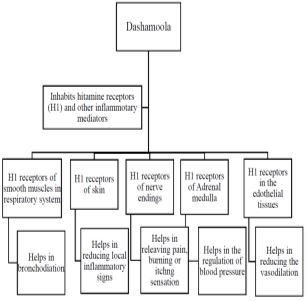Conceptual understanding of the Anti-inflammatory effects of Dashamoola with relevant Modern perspective : A critical study
Keywords:
Anti-inflammatory, Dashamoola, Inflammation, Shotha.Abstract
Inflammation is a part of the complex biological response of body tissues to harmful stimuli. Inflammation in Ayurveda is known by different names like Shotha, Shopha etc. Ayurveda treats the concept of inflammation as (a) Symptom of a disease (b) An independent disease and (c) A complication of diseases. There are numerous formulations explained by our Acharyas for the management of inflammation. Dashmoola is thought to be one of the most powerful combinations of several plants utilized in Ayurveda for the management of Shotha. The paper deals with the concept of understanding the Anti-inflammatory effects of Dashamoola in Ayurveda with relevant Modern perspective.
Downloads
References
Signore A. About inflammation and infection. EJNMMI Res. 2013;3(1):8. Published 2013 Feb 1. doi:10.1186/2191-219X-3-8
Ward SG. New drug targets in inflammation: efforts to expand the anti-inflammatory armoury. Br J Pharmacol. 2008;153 Suppl 1(Suppl 1): S5–S6. doi: 10.1038/sj.bjp.0707628
Ashok Kumar Panda, and Rabinarayan Tripathy. (2020). Concept Of Sopha (Inflammation): A Critical Study. International Journal of Research -Granthaalayah, 8(8), 15-23. https://doi.org/10.29121/granthaa layah.v8.i8.2020.692
Parekar RR, Bolegave SS, Marathe PA, Rege NN. Experimental evaluation of analgesic, anti-inflammatory and anti-platelet potential of Dashamoola. J Ayurveda Integr Med. 2015;6(1):11–18. doi:10.4103/0975- 9476.146565
Kumar, Vinay; Fausto, Nelso; Abbas, Abul (2004). Robbins & Cotran Pathologic Basis of Disease (7th ed.). Philadelphia, PA: Saunders. pp. 84–85.
Kumar, Vinay; Fausto, Nelso; Abbas, Abul (2004). Robbins & Cotran Pathologic Basis of Disease (7th ed.). Philadelphia, PA: Saunders. pp. 84–85.
Kaviraja Ambikadutta Shastri. Susruta Samhita of Maharsi Susruta. Ayurveda Tattva-Sandipika Hindi commentary. Chaukamba Sanskrit Sanstan. Chiktsasthana
Kaviraja Ambikadutta Shastri. Susruta Samhita of Maharsi Susruta. Ayurveda Tattva-Sandipika Hindi commentary
Mitchell RN and Cotran RS: Acute and chronic inflammation, in Kumar, Citran, Robbins: Basic pathology, 2003
Chung HY, Cesari M, Anton S, Marzetti E, Giovannini S, Seo AY, Carter C, Yu BP, Leeuwenburgh C: Molecular inflammation: underpinnings of aging and age-related diseases. Ageing Res Rev 2009; 8:18-30.
McGeer PL, McGeer EG. Inflammation and the degenerative diseases of aging. Ann N Y Acad Sci. 2004; 1035:104-16.
Sonya Vastoa, Giuseppina Candorea, Carmela Rita Balistreria et al. Inflammatory networks in ageing, age related diseases and longevity Mechanisms of Ageing and Development 2007; 128 (1):83-91.
Aggarwal BB, Prasad S, Reuter S, Kannappan R, Yadev VR, Park B, et al. Identification of Novel Anti-inflammatory Agents from Ayurvedic Medicine for Prevention of Chronic Diseases: “Reverse Pharmacology” and “Bedside to Bench” Approach. Curr Drug Targets. 2011; 12(11):1595-1653.
Chung HY, Cesari M, Anton S, Marzetti E, Giovannini S, Seo AY, Carter C, Yu BP, Leeuwenburgh C: Molecular inflammation: underpinnings of aging and age-related diseases. Ageing Res Rev 2009; 8:18-30.
Ashok Kumar Panda, and Rabinarayan Tripathy. (2020). Concept Of Sopha (Inflammation): A Critical Study. International Journal of Research -Granthaalayah, 8(8), 15-23. https://doi.org/10.29121/granthaa layah.v8.i8.2020.692
Bhalerao PP, Pawade RB, Joshi S. Evaluation of analgesic activity of Dashamoola formulation by using experimental models of pain. Indian J Basic Appl Med Res. 2015 Jun;4(3):245-55.
Sastry J L N. DravyagunaVijnana.Vol.2. Reprint. Varanasi: Chowkamba Orientalia, Jai krishna das Ayurveda series 114; 2012. p.98,108,160,164,371,367,399,403,418,426.
Barbosa-Filho JM, Piuvezam MR, Moura MD, Silva MS, Lima KV, da-Cunha EV, Fechine IM, Takemura OS. Anti-inflammatory activity of alkaloids: A twenty-century review. Revista Brasileira de Farmacognosia. 2006;16:109-39.
Wang Jing, Chen Xiaolan, Chen Yu, Qin Feng, Yang Haifeng,Pharmacological effects and mechanisms of tannic acid, Biomedicine & Pharmacotherapy,Volume 154,2022,113561,ISSN 0753-3322, https://doi.org/10.1016/j.biopha.2022.113561.
Baldwin A, Booth BW. Biomedical applications of tannic acid. J Biomater Appl. 2022 Mar;36(8):1503-1523. doi: 10.1177/08853282211058099. Epub 2022 Jan 7. PMID: 34991392.
Kumar S, Pandey AK. Chemistry and biological activities of flavonoids: an overview. Scientific World Journal. 2013 Dec 29;2013:162750. doi: 10.1155/2013/162750. PMID: 24470791; PMCID: PMC3891543.















